Canadian Aquaculture R&D Review 2015
Table of Contents
Shellfish: Mussels
THE INFLUENCE OF OFFSHORE AQUACULTURE ON LOBSTER MOVEMENT
Mussel aquaculture acts to aggregate lobster due to the provision of physical structure (anchor blocks) and food resources (mussel fall-off from culture structures and aggregation of crabs, which are the major prey of lobster). It has been hypothesized that lobster, once they happen upon a mussel farm, will not leave the area as some of their basic needs (i.e., habitat structure and food) are more abundant in these locations than others, particularly in areas with unstructured (i.e., sandy or muddy) bottoms, as is the case in offshore mussel farm locations in Îles de la Madeleine, Quebec. In this study, acoustic methods are being used to determine the affinity of lobster to a mussel culture site in Îles de la Madeleine. In short, 15 lobsters found within the culture site and 15 lobsters found in each of 2 areas outside of the culture site were fitted with acoustic transmitters, and placed back to where they were captured. Another 15 lobster were caught outside of the mussel farm, fitted with acoustic transmitters, and placed within the farm site. Lobster movements were followed within 3 arrays of 10 fixed receivers within, and in the two experimental areas established adjacent to, the farm site. After 2 months, receivers were recovered and lobster movements determined from recorded signals. The results of this work will increase our knowledge of the interactions between cultured bivalves and a commercially important species, and thus aid in the decision process for new lease sites.
Apr. 2013–Mar. 2016
Funded By: DFO – Aquaculture Collaborative Research and Development Program (DFO – ACRDP) Co-Funded By: La Société de développement de l’industrie maricole (SODIM); Ressources Aquatiques Québec (RAQ); Université du Québec à Rimouski (UQAR)
Project Lead: Chris McKindsey (DFO)
Project Team: Andrea Weise (DFO); Philippe Archambault, Émilie Simard (ISMER); Christian Vigneau (La moule du large Inc.)
Contact: Chris.Mckindsey@dfo-mpo.gc.ca
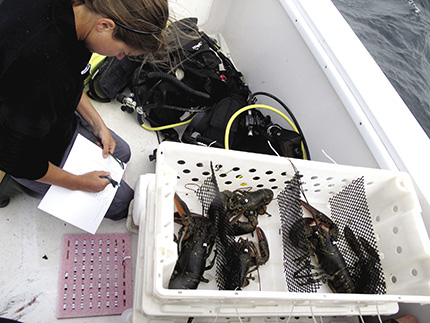
MSc. student, Émilie Simard, tags lobsters with acoustic transmitters to follow their movements within and around a mussel farm offshore of Îles de la Madeleine. Photo: Chris McKindsey (DFO)
INTERACTIONS BETWEEN OFFSHORE MUSSEL CULTURE AND COMMERCIALLY IMPORTANT SPECIES: EVALUATION OF DIRECT EFFECTS
In enclosed embayments, the abundance of benthic macro-invertebrates, such as lobsters and crabs, as well as fish are often increased due to the provision of physical structure or the fall-off of mussels from culture structures, which provides a direct or indirect food source to these organisms. Little work has evaluated the impact of mussel culture areas in offshore areas, which are more dispersive in nature and potentially have different functioning and suites of organisms associated with them. This project evaluates the influence of an offshore aquaculture site in Îles de la Madeleine, Quebec, on the spatial distribution of macro-invertebrates and fish. These communities were sampled by visual counts using scuba diving in multiple areas inside of and outside of the farm site in spring and summer. Sampling was done directly below mussel lines and at three distances from mussel lines in the farm, as well in the same configuration in areas outside of the farm, to see if small-scale effects were evident. This work will provide managers with a better understanding of the influence of mussel farms on commercially important species.
Apr. 2013–Mar. 2016
Funded By: DFO – Aquaculture Collaborative Research and Development Program (DFO – ACRDP) Co-Funded By: La Société de développement de l’industrie maricole (SODIM); Ressources Aquatiques Québec (RAQ); Université du Québec à Rimouski (UQAR)
Project Lead: Chris McKindsey (DFO)
Project Team: Annick Drouin, Anne-Sara Sean (DFO); Philippe Archambault (ISMER); Christian Vigneau (La moule du large Inc.)
Contact: Chris.Mckindsey@dfo-mpo.gc.ca

Divers quantify the abundance of benthic invertebrates and fish along transects inside of and outside of mussel culture sites offshore of Îles de la Madeleine. Photo: Chris McKindsey (DFO)
ECOLOGICAL CARRYING CAPACITY AND EVALUATION OF INDICATORS OF BENTHIC CONDITION FOR OFFSHORE MUSSEL CULTURE IN îLES DE LA MADELEINE
Wastes (faeces and pseudofaeces – together known as biodeposits) from filter-feeding bivalves grown in aquaculture may accumulate within and around farm sites, potentially organically enriching sediments and changing benthic communities and physiochemical indicators of this. Most work on this to date has been done within fairly protected and shallow areas where issues of ecological carrying capacity (i.e., the stocking density of farmed bivalves that will not produce unacceptable effects on, for example, benthic communities) have been widely addressed. Recently, interest in producing bivalves in more offshore locations has increased. This study is evaluating the ecological carrying capacity of the benthic environment for an offshore mussel aquaculture site in Îles de la Madeleine, Quebec, and indicators of benthic conditions. To this end, experiments are being done to measure mussel biodeposit production, which, when used to force a simple dispersal estimation model, will be used to predict patterns of benthic loading within and around a mussel farm. Benthic communities and sediment biogeochemical measures are being sampled in areas with normal levels of mussel production, as well as areas with much heightened levels of production, to determine how benthic communities are influenced by the culture activities and if standard chemical measures are appropriate to detect such effects. Results from this work will be useful in the event that producers in the area wish to seek eco-certification for their operations.
Apr. 2013–Mar. 2016
Funded By: DFO – Aquaculture Collaborative Research and Development Program (DFO – ACRDP) Co-Funded By: La Société de développement de l’industrie maricole (SODIM); Ressources Aquatiques Québec (RAQ); Université du Québec à Rimouski (UQAR)
Project Lead: Chris McKindsey (DFO)
Project Team: Annick Drouin, Andrea Weise (DFO); Philippe Archambault (ISMER); Christian Vigneau (La moule du large Inc.)
Contact: Chris.Mckindsey@dfo-mpo.gc.ca
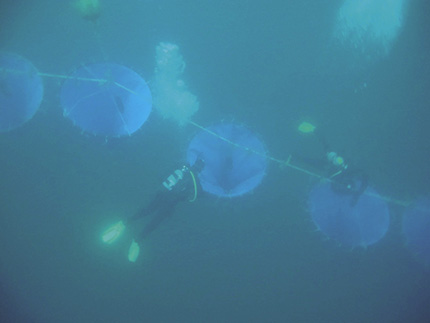
Divers work on large sediment traps to measure bio-deposit production by farmed mussels in îles de la Madeleine. Photo: François Roy (DFO)
MONITORING VARIABILITY OF ENVIRONMENTAL FACTORS IMPACTING TUNICATE INFESTATION ON COASTAL SHELLFISH FARMS IN NOVA SCOTIA
Results from this study may suggest an environmental factor to be used as an indicator to assess aquaculture sites (either current or future proposed sites) for their risk of infestation by the solitary Vase Tunicate (Ciona intestinalis) and inform siting decisions made by the government. This study may also help reduce further spread of this invasive species and the need for control treatments through the identification of sites less vulnerable to tunicate infestation.
The establishment of the Vase Tunicate, an invasive species in the waters of Nova Scotia and Prince Edward Island, has negatively impacted mussel farm productivity in these areas. Vase Tunicates grow in dense groups on mussel ropes, nets, and the mussels themselves. Aside from competing with mussels for space and potentially food, fouled gear is much more difficult to handle (during harvesting for example) and can result in crop losses. Tunicates must be removed following harvesting and in heavily fouled sites they must be removed at least once before harvest, which is both a time and resource-intensive process. Despite the various management techniques in use (e.g., pressure washing, brine dips, liming, UV treatment, electric shocks), once established, Vase Tunicates are sufficiently persistent that their presence has become a serious hindrance to the mussel industry, and in extreme cases has cost farmers their businesses. The spatial distribution of the Vase Tunicate is highly heterogeneous and could be the result of variation in environmental factors among sites. This project will examine the effect of variability of environmental factors (e.g., salinity, temperature, pH, and water movement) on the establishment and proliferation of Vase Tunicates.
Apr. 2013–Mar. 2015
Funded By: DFO – Aquaculture Collaborative Research and Development Program (DFO – ACRDP) Co-Funded By: La Société Aquaculture Association of Nova Scotia (AANS)
Project Lead: Dawn Sephton (DFO)
Collaborators: AANS
Contact: Dawn.Sephton@dfo-mpo.gc.ca
www.dfo-mpo.gc.ca/aquaculture/acrdp-pcrda/index-eng.htm
PRODUCTION CARRYING CAPACITY FOR OFFSHORE MUSSEL CULTURE IN îLES DE LA MADELEINE
Bivalves feed by filtering their food from the water. The removal of plankton by great densities of farmed bivalves may exceed the ability of plankton to be replenished, which has been shown to occur in some enclosed coastal areas. Recently, interest in producing bivalves in more offshore locations has been increasing but little work has addressed issues of production carrying capacity (stocking density of bivalves at which harvests are maximized – a function of plankton resources) in these situations. In this project, the production carrying capacity of an area that is being zoned for bivalve aquaculture offshore of Îles de la Madeleine, Quebec, was evaluated. This is being done by coupling a spatially explicit hydrodynamic model and a shellfish growth model that is forced by physical variables (e.g., plankton data, temperature) that were obtained through an enhanced monitoring programme that included constant monitoring using moored instruments and on-going in situ sampling of key parameters (e.g., chlorophyll levels), and mussel growth measurements, May through October 2013. The results from this research will help define sustainable levels of mussel culture densities in the area and how to optimally configure mussel lines within leases.
Apr. 2013–Mar. 2016
Funded By: DFO – Aquaculture Collaborative Research and Development Program (DFO – ACRDP) Co-Funded By: La Société de développement de l’industrie maricole (SODIM); Ressources Aquatiques Québec (RAQ); Université du Québec à Rimouski (UQAR)
Project Lead: Thomas Guyondet (DFO)
Project Team: Annick Drouin, Chris McKindsey, Andrea Weise (DFO); François Bourque (MAPAQ – Ministère de l’Agriculture, des Pêcheries et de l’Alimentation Québec); Madeleine Nadeau (MERINOV – Centre d’innovation de l’aquaculture et des pêches du Québec); Christian Vigneau (La moule du large Inc.)
Collaborators: La Société de développement de l’industrie maricole (SODIM); Ressources Aquatiques Québec (RAQ); U Québec à Rimouski (UQAR)
Contact: Thomas.Guyondet@dfo-mpo.gc.ca
www.dfo-mpo.gc.ca/aquaculture/acrdp-pcrda/index-eng.htm

Modelled influence of proposed mussel culture zone offshore of Îles de la Madeleine on plankton concentration under different farm stocking scenarios showing Seston Depletion Index (SDI) >0 when plankton concentration is reduced compared to the far-field. Photo: Thomas Guyondet (DFO)
EFFECTS OF HUSBANDRY PRACTICES AND MITIGATION TREATMENTS ON THE LONG-TERM CONTROL OF TUNICATE INFESTATION IN PEI MUSSEL FARMS
Tunicate infestations have severely impacted the shellfish aquaculture industry in Atlantic Canada, particularly the mussel aquaculture industry in PEI. This project will investigate the relationship between availability of recruitment space, and levels of infestation by the Solitary Tunicate, Ciona intestinalis, in mussel culture embayments. Effects of varying mussel stock density on the evolution of infestation levels will be assessed, including the particular case of fallowing of culture leases. The study will be conducted at the scale of a typical mussel aquaculture embayment, and will entail multi-year simulations to assess the overwintering potential of tunicates. The proposed methodology will rely on numerical modelling of multi-year population dynamics of C. intestinalis, informed by relevant in situ observations. A combination of treatment and mussel stocking scenarios, in particular those obtained for the fallowing of mussel farms, will be reproduced to provide valuable information for the long-term management of bay-scale infestation levels. Results from this project will contribute to the development of bay-scale regulations for culture practices, and mitigation measures for controlling tunicate fouling on cultured mussels.
Aug. 2014–Mar. 2017
Funded By: DFO – Program for Aquaculture Regulatory Research (DFO – PARR)
Project Lead: Thomas Landry, Thomas Guyondet (DFO)
Collaborators: Jeff Davidson, Thitiwan Patanasatienkul (AVC); Aaron Ramsay (PEI Department of Fisheries, Aquaculture and Rural Development)
Contact: Thomas.Landry@dfo-mpo.gc.ca, Thomas.Guyondet@dfo-mpo.gc.ca
COMPARISON OF THE HEALTH AND CONDITION OF CULTURED MUSSELS FROM DEEP WATER AND SHALLOW WATER SITES IN NEWFOUNDLAND WITH REFERENCE TO ENVIRONMENTAL CONDITIONS, CONDITION INDEX, PHYSIOLOGICAL STRESS, AND LIPID BIOCHEMISTRY
Little is understood about how the deep water environment specifically affects health and condition in mussels, as compared to the traditional shallow water coastal areas and how these benefits might be defined. This information will help industry make decisions regarding whether the utilization of deep water sites in Newfoundland will add increased sustainability for mussel culture in the region.
The Newfoundland mussel culture industry is poised to undergo a period of expansion in production due to increased utilization of existing approved culture sites as well as the development of new sites throughout the province. These sites are situated in sheltered near shore areas like estuaries, harbours, and shallow bays. Unfortunately, these zones can be affected by land runoff especially during times of significant precipitation and thus can be exposed to contaminants of land origin. Also, increased pressure for lease space in these areas has raised concerns with regard to carrying capacity and thus sustainability. Recently, increased interest in developing offshore and deep water bivalve culture and its associated technology has prompted Norlantic Processors Ltd., a Newfoundland based company, to begin adapting existing technology for the utilization of deep water mussel sites in the Notre Dame Bay region of the island. This project proposes to characterize and compare seasonal changes in environmental conditions in deep water and coastal shallow water mussel culture sites in Notre Dame Bay, Newfoundland, and investigate potential correlations between environment and mussel condition, physiological stress, and lipid biochemistry.
Apr. 2012– Mar. 2015
Funded By: DFO – Aquaculture Collaborative Research and Development Program (DFO – ACRDP) Co-Funded By: Norlantic Processors Ltd.
Project Lead: Harry Murray (DFO)
Project Team: Daria Gallardi, Dwight Drover, Sharon Kenny (DFO)
Collaborators: Terry Mills (Norlantic Processors Ltd.)
Contact: Harry.Murray@dfo-mpo.gc.ca
www.dfo-mpo.gc.ca/aquaculture/acrdp-pcrda/index-eng.htm
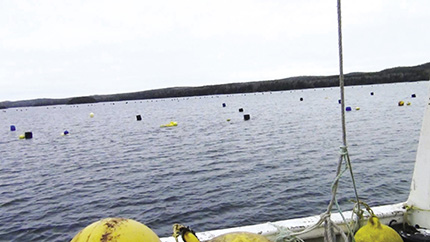
Deep water mussel site near Pleasantview, Notre Dame Bay, NL. Photo: Harry Murray (DFO)
PICOPHYTOPLANKTON CONTRIBUTION TO MYTILUS EDULIS GROWTH IN AN INTENSIVE CULTURE ENVIRONMENT
Autotrophic picoplankton (0.2–2.0 µm) is one of the most abundant phytoplankton components in marine ecosystems. The contribution of picophytoplankton to Blue Mussel (Mytilus edulis) growth was investigated in eastern Prince Edward Island (PEI), where the bulk of the Canadian suspension mussel industry is located. Flow cytometry was used to estimate the ability of mussels to retain picophytoplankton (0.2–2.0 µm) and nanophytoplankton (2–20 µm) in the field, along with size-fractioned phytoplankton biomass (chlorophyll-a), and mussel growth (shell and tissue). Retention efficiency (RE) for picophytoplankton (0.2–2.0 µm) and nanophytoplankton (2.0–20.0 µm) averaged 19.76 ± 2.03% and 60.21 ± 3.49%, respectively. RE and phytoplankton biomass were integrated into a Dynamic Energy Budget (DEB) model to investigate the contribution of picophytoplankton to mussel growth during the post-spring bloom period. When DEB simulations excluded picophytoplankton (RE = 0%), the predicted reduction in mussel growth ranged between 13.7% and 28.6%. It is concluded that the contribution of small sized phytoplankton to the mussel’s energy budget is non-negligible and should be taken into account to understand interactions bivalve farming and phytoplankton dynamics.
May 2009–Mar. 2013
Funded By: DFO – Program for Aquaculture Regulatory Research (DFO – PARR)
Project Lead: Rémi Sonier (DFO)
Project Team: Luc Comeau, Ramón Filgueira, Thomas Guyondet, Angeline LeBlanc, Michel Starr (DFO); Réjean Tremblay (ISMER); Frédéric Olivier, Tarik Meziane (MNHN)
Contact: Remi.Sonier@dfo-mpo.gc.ca
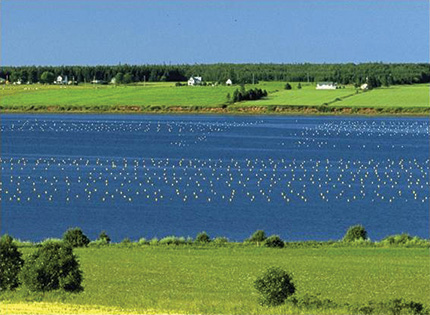
Blue Mussel (Mytilus edulis) farming in Prince Edward Island. Photo: Rémi Sonier (DFO)
AN INVESTIGATION OF THE LIPID AND FATTY ACID COMPOSITION OF THE BLUE MUSSEL, MYTILUS EDULIS, WITH REFERENCE TO PALATABILITY AND TASTE DURING CONDITIONS OF EXTENDED HOLDING
Blue Mussel (Mytilus edulis) culture is continuing to grow as an industry in eastern Canada and there is an increased market demand for fresh product, not just during peak seasons, but throughout the year. Consequently, wet storage facilities have become invaluable tools which allow the industry to maintain supply of their product through weather delays or stockpile their harvest for anticipated orders. The effects of extended holding by processing facilities on the biochemical composition of mussel tissue (lipid, fatty acid, and glycogen content) and meat quality (taste and palatability) remains largely unknown. This study assessed the physiological condition of cultured Blue Mussels held in a commercial wet storage facility under ambient environmental conditions. Newfoundland harvested mussels were held for one month each in fall, winter, and spring and then sampled weekly under industry standard conditions. Held mussels were compared directly with freshly harvested samples taken at the same point in time for changes in biochemical composition and quality. Results showed that while mussel condition was reduced after four weeks holding, biochemical composition was affected only by seasonality and not by holding conditions. Taste panellists were unable to differentiate between freshly harvested mussels and those kept in holding.
Apr. 2011–Mar. 2012
Funded By: DFO – Aquaculture Collaborative Research and Development Program (DFO – ACRDP) Co-Funded By: Norlantic Processors Ltd.
Project Lead: Harry Murray (DFO)
Project Team: Daria Gallardi, Kim Hobbs, Sharon Kenny, Gehan Mabrouk (DFO); Terry Mills (Norlantic Processors Ltd.)
Collaborators: Norlantic Processors Ltd.
Contact: Harry.Murray@dfo-mpo.gc.ca
www.dfo-mpo.gc.ca/aquaculture/acrdp-pcrda/index-eng.htm
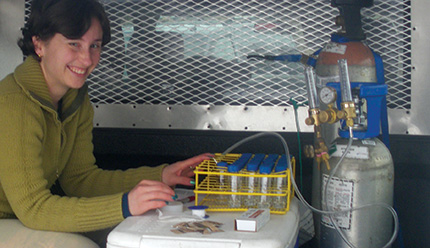
Biochemical composition analysis of mussel samples. Photo: Harry Murray (DFO)
SIMPLE MODEL ESTIMATIONS OF BAY-SCALE ECOLOGICAL CARRYING CAPACITY FOR SUSPENDED MUSSEL CULTURE
Sustainability issues related to the mussel culture industry were assessed using carrying capacity predictions based on food depletion criteria. Relatively simple model predictions (indices) of the present and optimal carrying capacity status of multiple coastal embayments were provided to support future regulatory decisions, to help identify sustainable aquaculture limits (thresholds), and to aid industry towards sustainability certification. The model incorporates the most important aspects of the carrying capacity calculation which affect the supply and removal of phytoplankton in a body of water under enhanced shellfish grazing pressure; these include the time it takes for a given bivalve population to filter the bay volume (clearance time), the time needed for tides to flush a bay and re-supply external food sources (residence time), and the time required for phytoplankton growth to replace internal food resources (phytoplankton doubling time). Ecological carrying capacity is expected to be reached when the removal of phytoplankton by all bivalve farms in an area exceeds the capacity of the ecosystem to replenish this critical marine food source. Such a condition would result in adverse dietary conditions for both wild and cultured populations. Calculations using existing data for multiple major shellfish culture embayments in Canada were expressed as an index of ecological carrying capacity. These calculations have proven to be a useful tool for identifying potentially problematic aquaculture sites where further research and detailed modeling programs can be deployed.
Apr. 2011–Mar. 2014
Funded By: DFO – Program for Aquaculture Regulatory Research (DFO – PARR)
Project Lead: Peter Cranford (DFO)
Project Team: Terri Sutherland, Luc Comeau, Gehan Mabrouk, Chris McKindsey (DFO)
Contact: Peter.Cranford@dfo-mpo.gc.ca

Bay-scale food depletion modelling can be an effective tool for identifying and assessing bay-scale ecological carrying capacity criteria.
EVALUATION OF BLUE MUSSEL PROCESSING PLANT HOLDING SYSTEMS IN PEI
Blue Mussel (Mytilus edulis) processors are looking for new and improved holding systems and methods to maintain high quality product and better compete in international markets. This study compared the traditional live mussel holding system to a newer chilled recirculation system. Specifically, researchers compared water quality, oxygen distribution, holding capacity, and shelf life of mussels, as well as evaluated emersion/immersion cycles on mussel shelf life (a method that mimics the life of successful intertidal mussels which are exposed out of water at low tide) between the two holding systems.
There were important differences in oxygen concentrations and pH (acidity) between the systems. Both systems exhibited an overall decrease in dissolved oxygen with prolonged holding times. Flow rate, water flow within the tanks (overflow positioning), and length of holding period should all be carefully considered in order to keep sufficient oxygen concentrations in mussel holding tanks. There was no clear evidence that one live holding system was better than the other in terms of condition index (the ratio between dry weight and total weight) and holding capacity. Preliminary results on emersion cycles were not promising, with increased holding mortalities and no increase in shelf life.
Additional research is required in order to determine if shellfish recirculating holding systems are able to hold live shellfish for extended periods without loss of quality and shelf life. A recirculating system could potentially allow the aquaculture industry to sell live shellfish even in the event of a shellfish harvesting closure in the area, whereas, processing plants using traditional holding systems (that continuously pump water from nearby bays) could not sell their product during a closure.
Apr. 2011–Mar. 2014
Funded By: DFO – Aquaculture Collaborative Research and Development Program (DFO – ACRDP) Co-Funded By: P.E.I. Mussel King (1994) Inc.
Project Lead: Daniel Bourque (DFO)
Collaborators: P.E.I. Mussel King (1994) Inc.
Contact: Daniel.Bourque@dfo-mpo.gc.ca
www.dfo-mpo.gc.ca/aquaculture/acrdp-pcrda/index-eng.htm
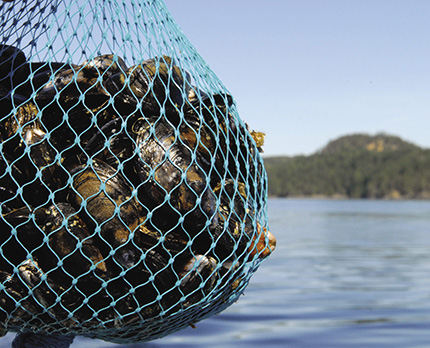
Blue Mussels. Photo: DFO
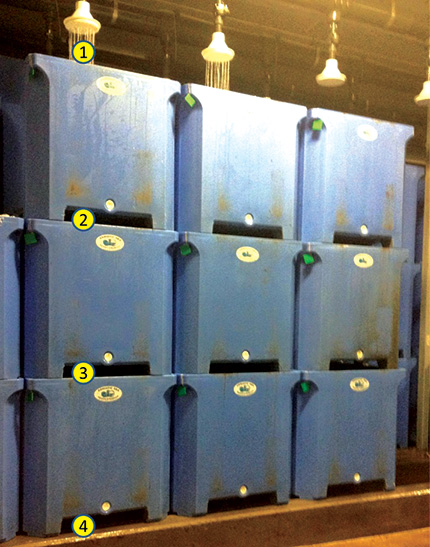
Stacked live mussel holding tanks. Water is introduced at the top, which then trickles down through the tanks to the bottom. Water sampling locations are indicated by the numbered yellow circles. Photo: Daniel Bourque (DFO).
HYDRATED LIME FOOTPRINT IN MUSSEL FARMS
The PEI mussel industry controls the invasive Clubbed Tunicate, Styela clava, by applying hydrated lime to mussel socks. DFO, Atlantic Veterinary College (AVC), and the province of PEI collaboratively monitored in situ pH changes during liming operations in Malpeque Bay. pH sensors were attached directly onto the treated mussel sleeves; other pH sensors were towed in the near vicinity of the treated socks or moored on the estuarine seabed.
Results indicated that the sock-scale pH signature is short-lived, generally disappearing within 10 minutes after the re-immersion of socks. No water-column pH signature was detected between one to seven meters away from the treated socks, whereas faint ephemeral signatures were detected on the seabed. This information is being assessed in the context of possible impacts on non-targeted species, such as crustaceans and other bivalves. The results of this study will inform stakeholders on the potential effects of expanding mussel culture in Malpeque Bay.
Jul. 2013–Mar. 2015
Funded By: DFO – Program for Aquaculture Regulatory Research (DFO – PARR)
Project Lead: Luc Comeau (DFO)
Project Team: Rémi Sonier, Thomas Landry (DFO)
Collaborators: Jonathan Hill, John Davidson, Jeffrey Davidson (AVC); Aaron Ramsay (PEI DFARD)
Contact: Luc.Comeau@dfo-mpo.gc.ca
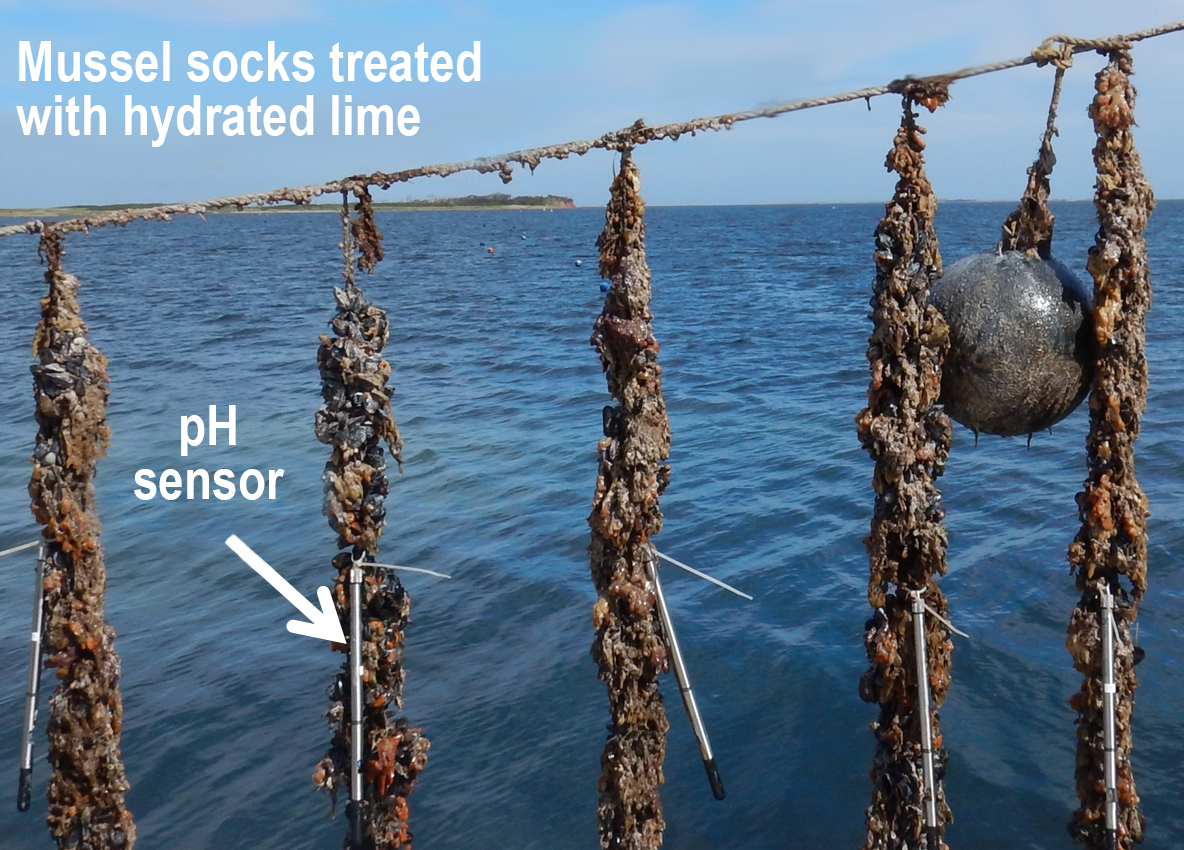
Mussel socks with pH sensors. Photo: Jonathan Hill
ASSESSMENT OF MUSSEL PRODUCTION STRATEGIES TO AVOID WILD DUCK PREDATION IN THE GRANDE-ENTRÉE LAGOON (MAGDALEN ISLANDS, QUEBEC)
Predation by wild ducks has affected the mussel industry for several years and causes considerable damage on some production sites. The various duck-scaring techniques tested to date (chasing by boat, sound recordings, gunshots, etc.) did not yield the desired results because they require a lot of energy and sometimes become ineffective when the birds become used to them.
In the Magdalen Islands (Quebec), the Grande-Entrée lagoon contains the only mussel culture site currently experiencing this problem. To support the industry, sock transfer strategies to sites that are free from ducks during critical periods of predation, are currently being tested. These scenarios involve high-density socking before the fall transfer and a second standard-density socking before the socks are returned to the usual culture site at the beginning of the summer. A third strategy is to install protective nets around culture longlines. This method, inspired by trials conducted in Norway, involves deploying nets perpendicularly around the lines to cover the entire water column. Buoys are used to keep the net approximately 60 cm above the water surface. The economics of the scenarios will be considered and will help determine the efficiency and profitability of each.
If the results are conclusive, they could lead to attractive benefits for a part of the mussel industry that must deal with this problem and its many consequences year after year.
Oct. 2013–Mar. 2016
Funded By: MAPAQ; Ministère des Finance et Économie (MFE) Co-Funded By: Merinov; Grande-Entrée Aquaculture Inc.; Culti-Mer Inc.; Biomer
Lead: Lise Chevarie (Merinov)
Project Team: Jean-François Laplante (Merinov); Élisabeth Varennes (UQAR)
Collaborators: Grande-Entrée Aquaculture Inc.; Culti-Mer Inc.; Biomer
Contact: Lise.Chevarie@merinov.ca

Claude Poirier deploying mussel socks. Photo: Lise Chevarie (Merinov)
- Date modified: